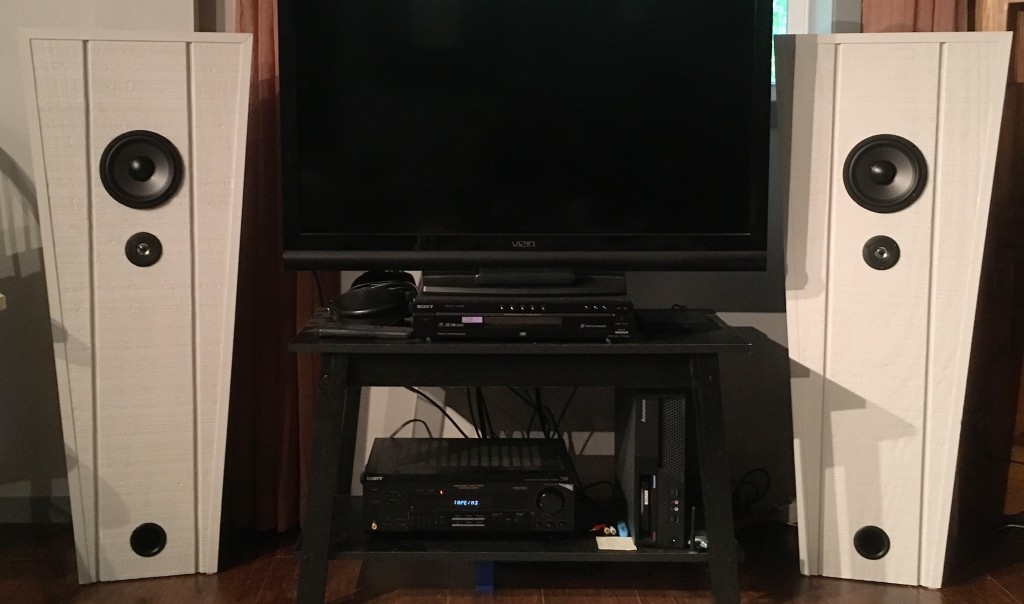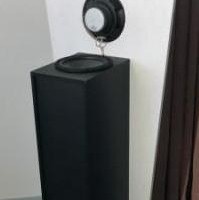
Budget Modified Open Baffle Towers
Designer:
JayTee
Project Category:
Tower Speakers
Project Level:
Beginner
Project Time:
1-8 Hours
Project Cost:
Under $100
Project Description:
I purchased a pair of Dayton Audio T652 tower speakers at a restocked bargain price ($63) and was quite impressed with the bass and overall sound they produced. I’m a big fan of open, airy sound stage when listening to music, so I thought “Why not use these speakers to create a modified open baffle design with little to no extra investment?”
Design Goals:
To incorporate all the elements of the Dayton T652 into a modified open baffle setup resulting in the expanded, room filling sound stage offered by open baffle designs at an “ultra budget” cost.
Driver Selection:
All components of the Dayton Audio T652 speaker pair were re-used. Wiring was performed without schematic alterations.
Enclosure Design:
The bass reflex cabinet of the Dayton Audio T652 was re-used and attached to the rear of a a 45″ tall by 19 inch wide tapered board design.
Enclosure Assembly:
Very little to do here other than to lay out the new board, cut it , trim it with boarder trim, Cut the driver and port tube holes, and paint it to whatever color is desired ( I used a shade of gray). The existing Dayton cabinet only required a 5-3/4 inch round hole in the top to be cut for re-attaching one of the existing drivers.
Crossover Design:
Same first order crossover used in the Dayton T652 (re-used).
Tips & Tricks:
Accurate measurements of the location of the front port and tweeter locations on the Dayton Audio T652 cabinet front are required in order to layout and cut the new openings on the front attached wood baffle. The port tube is glued into the Dayton cabinet. I used a drill to pilot a hole and a jig saw to cut about 1/4 inch around the port tube to remove it and then broke-off the remaining MDF cabinet pieces attached to the port tube with vise grips. A 5-3/4 hole must be cut in the top of the Dayton cabinet to acomodate an upward firing driver. The existing wiring needed to be modified to lengthen the leads from the terminals to extend out the top of the newly cut opening in order to re-attach (solder) all drivers. This can be done my splicing or by remove/re-attaching at the speaker terminals (this must be done before attaching the Dayton cabinet to the new front baffle board). I drilled 6 new holes in the front of the Dayton cabinet and used 6 ph ilips head screws no deeper than the combined depth of the Dayton cabinet and the new front baffle board to attach the cabinets to the board (also used foam weatherstrip tape to fully seal the cabinet front to the new board and eliminate any additional vibration potential). I needed to use a “stubby” phillips screw driver and reached down inside the cabinet to tighten all 6 screws to finish attaching the front board (this hides all of the screws completely). I used hole saws from my standard hole saw kit to cut the new openings for the tweeter and port tube in the front board, which is aligned and attached directly over the original Dayton Audio T652 mounting holes. I used a drilled pilot hole and jig saw to cut the woofer holes in the new front boards and the top of the Dayton cabinets.
Conclusion:
They look and sound great to me!….I wasn’t planning to do a photo step by step so I only have a front and back view of the finished product to share.
About the Designer:
I’m just about a complete “newbie” and have only performed re-foams and cap replacements to this point. I don’t make any claims that the work I performed in this project should be done by others, but I personally love the results for both sound and appearance in my den. Dayton Audio makes a great budget product with their T652 speakers and I simply sought to improve them to my taste and share the results from a happy DIY customer.
Parts Used:
All components of the Dayton T652 speakers.
Plus some scrap T-111 and wood trim ( yeah, I know it doesn’t have the acoustics of MDF but it’s what I had available and it works) and a few screws, 2 4′ pcs of 16 awg speaker wire, solder, weather stripping and paint.



Thank you for doing this. I have thought about doing the same type of thing with some old Fishers that sound decent. I would reuse most of it keep the cabinet volume. The mid is open back so I thought I would spread the sound out a bit. Good inspiration.